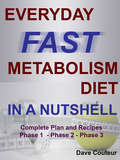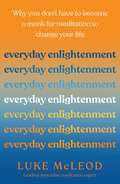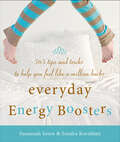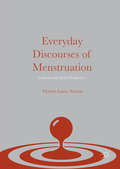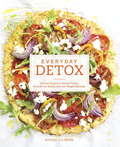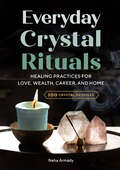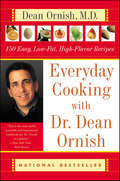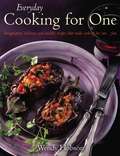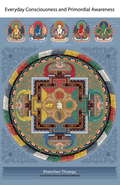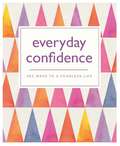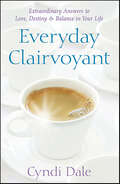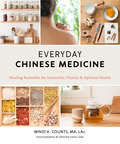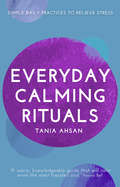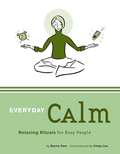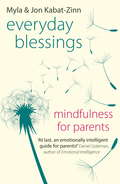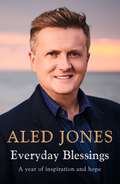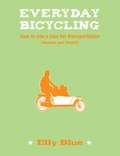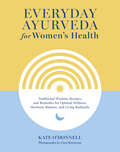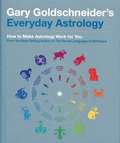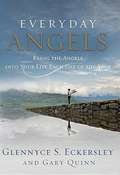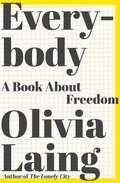- Table View
- List View
Everyday Fast Metabolism Diet In a Nutshell: Complete Plan and Recipes Phase 1 - Phase 2 - Phase 3
by Dave CouteurThe Everyday Fast Metabolism Diet focuses on simple strategies to boost your metabolism. It's actually based on a lot of the same functional medicine, getting to the root causes of things. The diet plan advises people not to eat processed foods, junk, gluten, dairy, corn, soy, caffeine, and alcohol. The diet recommends eating small meals, and focuses on the quality of the food, not counting calories. It works on Diet confusion, cycling diet with a change in strategy every few days Phase 1: high-glycemic, moderate-protein, low-fat: days 1 and 2 Phase 2: high-protein, high-vegetable, low-carbohydrate, low-fat: days 3 and 4 Phase 3: high healthy-fat, moderate-carbohydrate, moderate-protein, low-glycemic fruit: days 5, 6, and 7 You will find in this book phase 1,2 and 3 basic guide with Phase 1 (51 Recipes), Phase 2(91 Recipes), Phase 3 (59 Recipes)
Everyday Enlightenment: Why you don't have to become a monk for meditation to change your life
by Luke McLeodPeace. Calm. Mindfulness. Enlightenment.These are appealing concepts, but they never seem like they're within grasp of the everyday person. With all our responsibilities in life, most of us are doing our best just to keep up, let alone have time to find that elusive 'inner calm'.Luke McLeod knows all about this. He's an everyday person. He's a son, a husband and a friend, trying to find some balance in his everyday life just like everyone else.There is one thing, though, he knows for sure has improved his quality of life every single day.Meditation.Luke used to believe meditation wasn't for him but has now become one of Australia's leading meditation experts helping thousands of 'everyday' people, just like himself, enjoy meditation in an easy, down-to-earth way.Everyday Enlightenment contains encouragement, support, guidance, advice and short meditations to help you start, enjoy and embrace your meditation journey. Let Luke help you find some of that inner peace and calmness without having to move to the mountains and become a monk. Let him show you how the secret to living an enlightened life is hidden within the ordinary and the everyday - it will be one of the best things you ever do.
Everyday Energy Boosters: 365 Tips and Tricks to Help You Feel Like a Million Bucks
by Sondra Kornblatt Susannah SetonAn All-Natural, Holistic Approach to Energy BoostingSay no to another cup of coffee and YES to these wellness tips from authors and health gurus Sondra Kornblatt and Susannah Seton. Whether you’re looking for a midday pick-me-up or an extra boost first thing in the morning, their tips can help.The alternative to caffeine. Coffee and energy drinks are not your only options when it comes to boosting your energy—and they’re certainly not your healthiest options. This book contains all the information you need to stay energized all day long, without relying on caffeine. Authors Kornblatt and Seton have researched and compiled 365 quick and easy tips and tricks that anyone can use to find and sustain the energy they need to get through the day.Embrace a new kind of life. Not only do these health tips serve as energy boosters, but they can also help you create a calmer, more positive life. By helping you track your natural energy cycles, get organized, and sleep better, this book promises to change your life in a big way. When you’re feeling depleted and tired, you’re not your best healthy and happy self. In adopting these habits, you bring yourself one step closer to creating the life you want and deserve.Here’s a look at some of the pick-me-ups and tips they offer:Juices, nuts and seeds to keep you energized all dayDeep breathing techniquesTips for getting more sleep, and more!Readers of books like Your Simplest Life, A Year of Positive Thinking, Better than Before, or Keep Going will love Everyday Energy Boosters.
Everyday Discourses of Menstruation
by Victoria Louise NewtonMenstruation is a topic which is both everyday and sensitive. From Leviticus to Pliny, to twentieth-century debates around 'menotoxin', to advertising and 'having the painters in', Victoria Newton's book offers a lively and innovative exploration of the social and cultural dimensions of menstruation. Through in-depth interviews with men and women, the book explores the many different ways in which this sensitive topic is spoken about in British culture. Looking specifically at euphemism, jokes, popular knowledge, everyday experience and folklore, the book provides original insights into the different discourses acting on the menstruating body and encourages debate about how these help to shape our everyday attitudes towards menstruation.
Everyday Detox: 100 Easy Recipes to Remove Toxins, Promote Gut Health, and Lose Weight Naturally
by Megan GilmoreA healthy guide to detoxing naturally, all year round--no dieting, juice fasting, or calorie counting required--to lose weight, improve digestion, sleep better, and feel great, featuring 100 properly combined recipes for every meal of the day. Most diets and cleanses have all-or-nothing rules that encourage unhealthy cycles of intense restriction followed by inevitable bingeing. In this healthy guide to detoxing naturally, nutritionist and blogger Megan Gilmore shares 100 delicious, properly combined recipes that will leave you feeling satisfied and well nourished while promoting weight loss and improving digestion and sleep.Because the recipes were developed with digestion mechanics in mind, detoxers won't feel bloated or uncomfortable after eating. And crowd-pleasing recipes for every meal of the day--such as Banana Coconut Muffins, Chocolate Chia Shake, Broccoli Cheese Soup, Mediterranean Chopped Salad, Skillet Fish Tacos, Cauliflower Flatbread Pizza, and Peppermint Fudge Bars--are packed with all-natural, whole-foods ingredients designed to stave off feelings of deprivation. With helpful information on how to stock your detox-friendly kitchen plus a handy food-combining cheat sheet that demystifies this cutting-edge health principle, Everyday Detox makes it easy to start eating this way today.From the Trade Paperback edition.
Everyday Crystal Rituals: Healing Practices for Love, Wealth, Career, and Home
by Naha ArmádyManifest desires with crystal healing prescriptions for your home, career, and relationship from Everyday Crystal Rituals. Crystal rituals channel inner desires to create outward change. In Everyday Crystal Rituals, you'll learn practical applications to crystal healing and manifest the life you want to lead at home, work, and in love. From mending broken hearts, to removing career obstacles, to inviting creativity into your home, these rituals make sacred practices part of your daily routine. Complete with 100 crystal profiles that explain their individual healing powers, plus an introduction on tuning into crystal energy, Everyday Crystal Rituals is your down-to-earth guide for healing with crystals. Everyday Crystal Rituals awakens your ability to live in fulfillment, love, and abundance with: An introduction to crystal healing that explains how to call on crystal energy and manifest powerful intentions with purpose. 60 rituals for focused healing of real obstacles around love and relationships, career, wealth, and home life. 100 profiles of the most common crystals with practical information on how to use them to achieve your life goals. Whether you're new to working with crystals or they're already a big part of your life, Everyday Crystal Rituals makes manifesting positive change a daily ritual.
Everyday Cooking with Dr. Dean Ornish: 150 Easy, Low-Fat, High-Flavor Recipes
by Dean OrnishRenowned cardiac researcher and bestselling author Dean Ornish, M.D., has inspired millions of people to choose a healthier lifestyle and a low-fat diet. But low-fat cooking can be time-consuming and hard to fit into a busy schedule, so Dr. Ornish has found 150 wonderful ways to make it fast, delicious and fun. Everyday Cooking with Dean Ornish includes 150 easy and extraordinary recipes that are extremely low in fat and cholesterol -- and high in flavor. You'll find slimmed-down versions of comfort foods that are delicious and nutritious, from French Toast and Hashed Browns to enchiladas and lasagna, from Creamy Corn Soup and Spicy Arkansas Chili to Southwest Pizza and Carrot Cake with Cream Cheese Frosting. The recipes are quick to prepare, the ingredients are familiar and inexpensive and there are hundreds of smart time-saving tips on cooking, shopping and serving. Now you no longer have to choose between good food and good health.
Everyday Cooking For One: Imaginative, Delicious and Healthy Recipes That Make Cooking for One ... Fun
by Wendy HobsonLiving on your own doesn't mean losing out on interesting and healthy food. Nor does it haveto involve the often unreliable business of quartering recipes! Here is a collection of simple,delicious meals - specially designed for one - that will ensure you enjoy your everyday eating.You'll find useful tips for shopping and stocking your food cupboard and delicious recipes foreverything from snacks to main courses with fish, meat and vegetables. Quick, easy andeconomical, the recipes are designed to make everyday cooking exciting, and to keep your diethealthy and balanced.Some recipes just don't work in small quantities, and that could include some of yourfavourites. A unique feature of this book is the inclusion of really tasty recipes - such ascasseroles, roasts and cakes - that show you how to create four differentmeals from one singlecooking session.So you can try:Braised Tender Lamb, then reinvent it as Lamb with Mediterranean Couscous, Lamb withCrisp Courgettes and Parsnip-topped Lamb Or treat yourself to: Roast Lemon-infused Chicken, then enjoy Chicken Filo Parcels, Sweet and Sour Chickenand Chicken with Pancetta Or simply enjoy just-for-one treats such as:Caramelised Onion and Goats' Cheese PuffsSalmon Steak with Summer Vegetable Parcels Spinach and Avocado Salad with PancettaHoney-drenched Tunisian Almond CakeAuthor Wendy Hobsonhas spent a career working in and around cooking. She has written several books - including Classic 1000 Cake & Bake Recipes, Classic 1000 Recipesand The Kitchen Companion - and edited manymore. She loves being able to cook in small quantities to please herself as well as in larger amounts to share with family and friends.
Everyday Consciousness and Primordial Awareness
by Khenchen Thrangu RinpocheTransformation of five afflictions into buddha wisdoms
Everyday Confidence: 365 ways to a fearless life (365 Ways to Everyday...)
by Everyday ConfidenceFilled with positive affirmations from a host of inspiring people, as well as easy-to-action suggestions for building up your sense of self-worth, Everyday Confidence will inspire and encourage you to stand up for yourself. With daily tips and brave actions for boosting your courage, this book helps you to take small, significant steps to an assertive and truly confident you.About the Everyday seriesGet to grips with a single subject in small, manageable steps with the Everyday series. From inspirational quotes to professional tips, the short daily entries fit perfectly into the hustle and bustle of everyday life. These small, chunky books are a perfect gift as well as a great self-purchase.
Everyday Confidence: 365 ways to a fearless life
by PyramidFilled with positive affirmations from a host of inspiring people, as well as easy-to-action suggestions for building up your sense of self-worth, Everyday Confidence will inspire and encourage you to stand up for yourself. With daily tips and brave actions for boosting your courage, this book helps you to take small, significant steps to an assertive and truly confident you.About the Everyday seriesGet to grips with a single subject in small, manageable steps with the Everyday series. From inspirational quotes to professional tips, the short daily entries fit perfectly into the hustle and bustle of everyday life. These small, chunky books are a perfect gift as well as a great self-purchase.
Everyday Clairvoyant: Extraordinary Answers to Finding Love, Destiny & Balance in Your Life
by Cyndi DaleProfessional clairvoyant and best-selling author Cyndi Dale has provided intuitive consulting and healing to more than 30,000 individuals, helping them lead more happy, successful, and fulfilling lives. Now she shares true personal stories and practical advice on how intuition can help you with everything from everyday concerns to major life decisions.Presented in an easy-to-follow Q&A format, the wisdom and guidance within these pages is organized into three categories: relationships, work or destiny, and health. Heartwarming, humorous, and surprisingly down to earth, Everyday Clairvoyant also offers tips and techniques for developing your own intuition, while offering insight on questions like the following:How will I know when I've met my true love?Do our children select us before birth?What are Indigo and Crystal souls?Are there ghosts?Do animals have souls?Does everyone have a spirit guide?How can I find my true life path?
Everyday Chinese Medicine: Healing Remedies for Immunity, Vitality, and Optimal Health
by Mindi K. CountsAchieve vibrant health in every season with the holistic techniques of traditional Chinese medicine.This friendly guide to a 2,000-year-old lineage of healing wisdom integrates both the Five Element theory and the practices of traditional Chinese medicine to uncover what your body needs for balance and optimal health. Everyday Chinese Medicine demystifies, simplifies, and reveals patterns to help you take control of your own well-being from the comfort of your own home and kitchen. Mindi Counts—a holistic medical practitioner, acupuncturist, and herbalist—walks you through the seasons, elements, and organ systems to help you understand your unique constitution and how to achieve energetic and physical balance. With simple recipes, self-care practices, and time-tested herbal remedies, Everyday Chinese Medicine is the perfect companion on your path to complete wellness.
Everyday Calming Rituals: Simple Daily Practices to Reduce Stress
by Tania Ahsan‘A warm, knowledgeable guide that will calm even the most frazzled soul.’ - Poorna Bell, author, In Search of Silence Rituals motivate and move us, they connect us to what is important and provide a time for contemplation and reflection. Rituals involve the execution of conscious and deliberate actions, they help us feel renewed and to become more in tune with what is truly meaningful. Actively working with rituals and your senses to create daily practices that you can draw on to create calm is an easy, everyday way to work with your body. This book will enable you to create simple rituals that will allow you to work with your five main senses to ensure you have a first aid kit of emotional associations that will calm you down when you are beset with a racing mind, insomnia or general stress and worry. Rituals featured include: Vision boards, mindful listening, smudging, self massage and tea ceremonies The book also includes daily, weekly and monthly rituals which you can easily integrate into your life.
Everyday Calm
by Cindy Luu Darrin ZeerA quarter of a million readers have relaxed in the workplace thanks to Darrin Zeer's Office Yoga and Office Spa. Now Everyday Calm offers over 50 fun and simple ideas for daily stress relief no matter where you are. Start the morning with a Yoga Yawn to wake up your face and feel energized. Rely on the contents of a Spa on the Go bag to turn waiting in line into a pampering escape. And make ReinCARnation work for you when you can't find your car in a crowded parking lot. Using his expert knowledge of yoga, meditation, aromatherapy, massage, and feng shui, Zeer creates effective stress-busters that are easy to do on the way home from work, at the supermarket, and even at the movies. Packed with Cindy Luu's charming illustrations, Everyday Calm delivers anytime-anywhere stress relief.
Everyday Blessings: Mindfulness for Parents
by Jon Kabat-Zinn Myla Kabat-ZinnEveryday Blessings is a practical and inspiring book which offers a clear outline for people who want to understand and embrace mindful parenting. It is one of the few books on parenting that embraces the emotional, intuitive and deeply personal experience of being a parent and shows you how to apply the practice of mindfulness meditation to parenting children of all ages. In the rush, rush, rush of too-much-to-do-and-no-time-to-do-it , the important, nurturing aspects of parenthood can easily disappear. Even the smallest degree of mindfulness can have profound effects on children, no matter how old they are, and on the quality of parent-child relationships. Jon Kabat-Zinn, a mindfulness pioneer, and his wife Myla share their experiences of using mindfulness within their own family. By encouraging moment-to-moment awareness and acceptance, this thoughtful and practical book will help you to slow down, grow in compassion, enrich your life as a parent and nourish the internal life of your children.
Everyday Blessings: Inspirational words of comfort and hope
by Aled JonesDaily life is so busy that it's hard to see the wood for the trees. Take a few minutes each day to ponder a nugget of wisdom chosen especially for you by singer and presenter Aled Jones.Aled's faith in God has sustained him all his life -- it is a God that speaks and exists through all things, times and places. Drawing on spritual wisdom across the ages, from ancient times to the modern day, as well as across diverse cultures, Aled has compiled a daily reader that will help ground and inspire you each day of the year. The year is divided up into monthly themes, ranging from New Beginnings, to treasuring the little things in life and the power of a smile. Charming line drawing illustrations decorate the page and journalling space allows the reader to respond to what they are reading by either making notes or with a drawing of their own.A book that's perfect as a gift for mum or dad, it is perfect to dip in and out of during the year and will be a favourite treasure trove of wisdom for all who love watching Aled on BBC TV or listen to his inspiring show on Classic FM. Complied by the singer Aled Jones, this book is a compilation of blessings to read throughout the year. Each page is illustrated with a quote to bring you joy and peace everyday.
Everyday Blessings: Inspirational words of comfort and hope
by Aled JonesDaily life is so busy that it's hard to see the wood for the trees. Take a few minutes each day to ponder a nugget of wisdom chosen especially for you by singer and presenter Aled Jones.Aled's faith in God has sustained him all his life -- it is a God that speaks and exists through all things, times and places. Drawing on spritual wisdom across the ages, from ancient times to the modern day, as well as across diverse cultures, Aled has compiled a daily reader that will help ground and inspire you each day of the year. The year is divided up into monthly themes, ranging from New Beginnings, to treasuring the little things in life and the power of a smile. Charming line drawing illustrations decorate the page and journalling space allows the reader to respond to what they are reading by either making notes or with a drawing of their own.A book that's perfect as a gift for mum or dad, it is perfect to dip in and out of during the year and will be a favourite treasure trove of wisdom for all who love watching Aled on BBC TV or listen to his inspiring show on Classic FM. Complied by the singer Aled Jones, this book is a compilation of blessings to read throughout the year. Each page is illustrated with a quote to bring you joy and peace everyday.
Everyday Bicycling
by Elly BlueEveryday Bicycling is a guide to everything you need to know to get started riding a bicycle for transportation. Elly Blue introduces you to the basics, including street smarts, bike shopping, dressing professionally, carrying everything from groceries to children to furniture, and riding in all weather. With its positive, practical approach, this book is perfect for anyone who has ever dreamed of riding a bicycle for transportation.
Everyday Ayurveda for Women's Health: Traditional Wisdom, Recipes, and Remedies for Optimal Wellness, Hormone Balance, and Living Radiantly
by Kate O'DonnellFind a deeper sense of wellness fueled by self-care, nurturing routines, healing foods, and herbal remedies—for women of any age.Learn the ancient wisdom of Ayurvedic living through 60+ recipes and practices, including 50+ photos.The ancient science of Ayurveda brings us back into relationship with the rhythms of our lives, streamlining our daily habits and attuning our activities by time of day and seasons. Everyday Ayurveda for Women's Health delivers insights into personal health, hormonal balance, and connection to nature, all from the simplest practices: what we eat. Food and herbs are medicine for body, mind, and soul. Kate O'Donnell empowers women of any age to become intimate with their body, how it works, how it changes over time, and how to listen to its messages. Her practical guide will inspire you to experience radiant health from the inside out. With Everyday Ayurveda for Women&’s Health you can: • Reclaim your health by adopting a more healing diet • Balance your hormones by choosing foods, herbs, and healing practices that are right for your constitution—60+ recipes, including herbal ghees, shatavari, beneficial oils, and more • Become more luminous and empowered with divine feminine and lunar energy, the subtle body, and more • Understand your current season of life—whether it involves menstruation, pregnancy, infertility, perimenopause, or menopauseThe traditional Ayurveda wisdom in this book is accessible for all and will help you navigate any stage of life with grace.
Everyday Ayurveda Cooking for a Calm, Clear Mind: 100 Simple Sattvic Recipes
by Kate O'Donnell Cara BrostrumEat your way to increased energy, balanced emotions, and an overall state of calm and relaxation. In Ayurvedic medicine there are said to be three main energies that affect our mind: • sattva, the state of contentment and calm; • rajas, the state of reactivity and excitability; and • tamas, the dull, slow, and stagnant state of mind.The good news is that there are direct ways of bringing these states into balance through what we eat. The recipes in this book are simple, seasonal, and delicious, while bringing the traditional foods of Ayurveda into the modern kitchen.Everyday Ayurveda Cooking for a Calm, Clear Mind uncovers the true potential of food to heal not only our bodies, but our minds too.
Everyday Astrology: How to Make Astrology Work for You
by Gary GoldschneiderThe bestselling author of "The Secret Language of Birthdays" returns with the definitive astrology handbook.
Everyday Angels
by Gary Quinn Eckersley Glennyce S.With this angelic almanac, Eckersley and Quinn offer a daily guide to attracting angels into your life. Experience how the angels are by your side throughout the year, guiding you through the seasons and watching over you with love. .
Everyday Angels
by Gary Quinn Glennyce EckersleyWith this angelic almanac, Eckersley and Quinn offer a daily guide to attracting angels into your life. Experience how the angels are by your side throughout the year, guiding you through the seasons and watching over you with love.
Everybody: A Book About Freedom
by Olivia Laing"Astute and consistently surprising critic" (NPR) Olivia Laing investigates the body and its discontents through the great freedom movements of the twentieth century. The body is a source of pleasure and of pain, at once hopelessly vulnerable and radiant with power. In her ambitious, brilliant sixth book, Olivia Laing charts an electrifying course through the long struggle for bodily freedom, using the life of the renegade psychoanalyst Wilhelm Reich to explore gay rights and sexual liberation, feminism, and the civil rights movement. Drawing on her own experiences in protest and alternative medicine, and traveling from Weimar Berlin to the prisons of McCarthy-era America, Laing grapples with some of the most significant and complicated figures of the past century—among them Nina Simone, Christopher Isherwood, Andrea Dworkin, Sigmund Freud, Susan Sontag, and Malcolm X. Despite its many burdens, the body remains a source of power, even in an era as technologized and automated as our own. Arriving at a moment in which basic bodily rights are once again imperiled, Everybody is an investigation into the forces arranged against freedom and a celebration of how ordinary human bodies can resist oppression and reshape the world.
